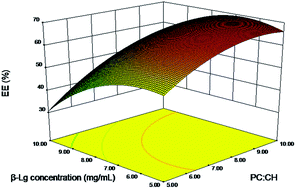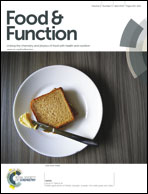Response surface methodology for the optimization of beta-lactoglobulin nano-liposomes
Abstract
Response surface methodology based on a central composite rotatable design has been successfully used to model and optimize biochemical and biotechnological processes. Heat treatment could have an effect on beta-lactoglobulin (β-Lg) and lead to allergic reaction. To reduce this phenomenon, liposomes were used as carriers in this research. The mass ratio of phosphatidylcholine and cholesterol (2.5–12.5), β-Lg concentration (2.5–12.5 mg mL−1), sonication time (5–25, min) and temperature (25–40 °C) were selected as independent variables with encapsulation efficiency as a dependent variable. For each response, a second-order polynomial model was developed using multiple linear regression analysis. Applying a desirability function method the optimum parameters were: phosphatidylcholine to cholesterol ratio of 8.05, β-Lg concentration of 9.09 mg mL−1, sonication time of 17.71 min and temperature of 30 °C. The particle size and encapsulation efficiency were found to be 189 nm and 61.55%, respectively. Furthermore, the in vitro stability of β-Lg nano-liposomes in simulated gastrointestinal juice was evaluated. The nano-liposomes showed an acceptable stability in simulated gastrointestinal juice at 37 °C for 4 h.


 Please wait while we load your content...
Please wait while we load your content...